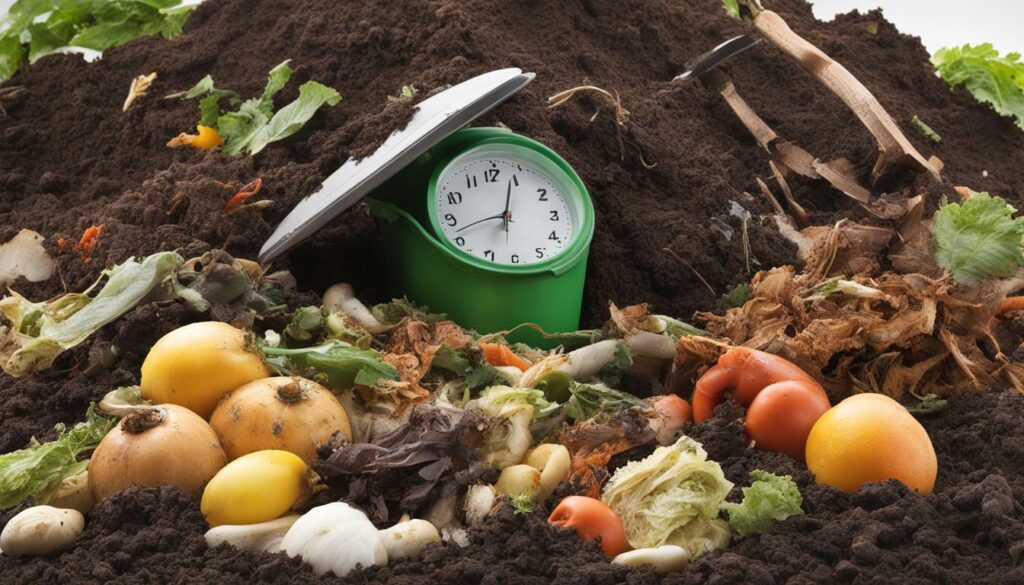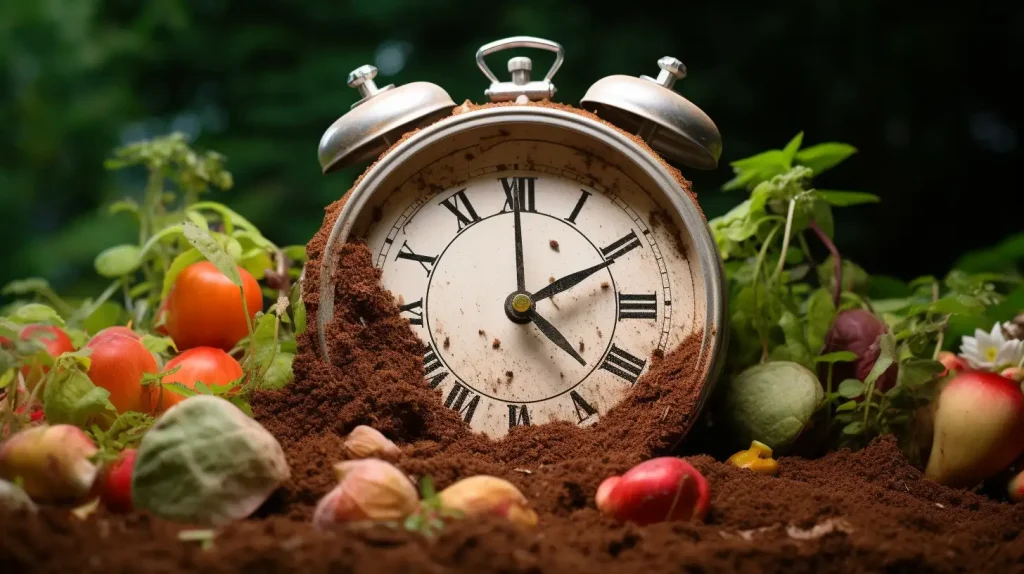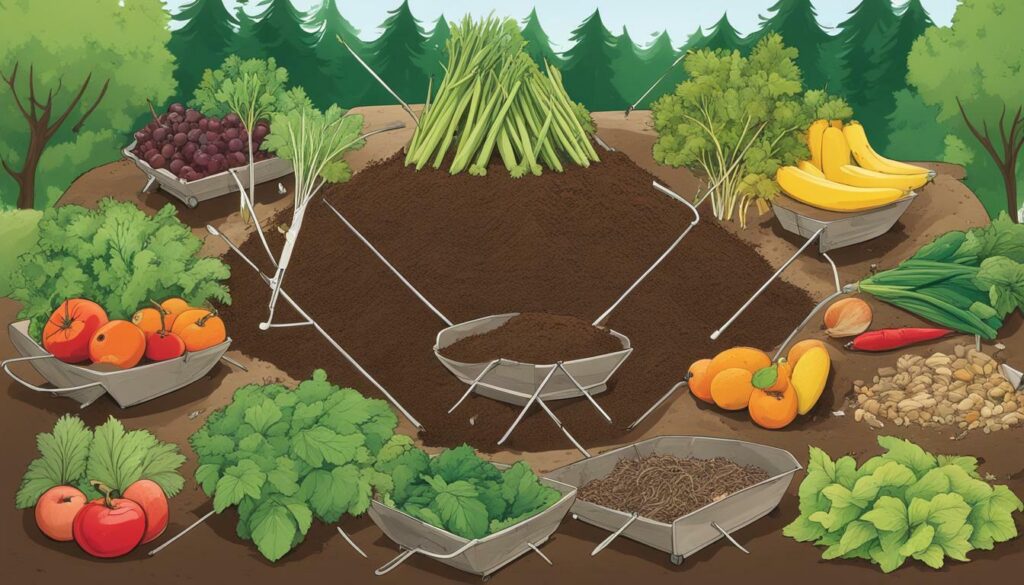The composting process is a natural way to create nutrient-rich soil for gardens, landscaping, and farms. But how long does it take for composting to occur? The answer depends on several factors, including the type and size of materials being composted, moisture levels, temperature, oxygen presence, and the chosen composting method.
Understanding these factors can help you optimize your composting process for maximum efficiency. In this section, we will explore the various elements that affect the duration of composting and how you can speed up the process to get nutrient-rich compost in less time.
Key Takeaways:
- The time it takes for composting depends on several factors, including the materials being composted, moisture levels, temperature, oxygen presence, and the chosen composting method.
- Understanding these factors can help optimize your composting process for maximum efficiency.
Understanding the Composting Process
Before discussing the composting time, it’s essential to understand the composting process itself. Composting is a natural decomposition process where organic matter such as food scraps, yard waste, and other biodegradable materials break down into nutrient-rich soil. During composting, microorganisms such as bacteria and fungi break down the organic materials, turning them into a rich soil amendment.
Factors Affecting Composting Time
The duration of composting varies according to several factors. These include the type and size of materials, carbon-to-nitrogen ratio, moisture levels, temperature, and oxygen levels.
The larger the particle size, the longer it takes to break down. High-carbon materials, such as branches and leaves, require more time to compost than high-nitrogen materials, like food waste and grass clippings. The carbon-to-nitrogen ratio affects the speed of composting, with a balanced ratio of 30:1 being optimal.
Moisture levels also play a vital role in composting. Moisture levels should be similar to that of a wrung-out sponge. Too much moisture can lead to anaerobic conditions, slowing down the decomposition process, while insufficient moisture hinders microbial activity.
Temperature is another essential factor influencing the rate of composting. Microbes responsible for breaking down organic matter are most active in temperatures between 110-160°F (43-71°C). Maintaining optimal temperature conditions can significantly accelerate the composting process.
Adequate oxygen levels are also essential for efficient composting. Turning the pile regularly provides proper aeration and creates an aerobic environment. This allows beneficial bacteria and fungi to thrive, speeding up the decomposition process.
The chosen composting method can also affect the duration of the composting process. Traditional composting in open piles or compost bins usually takes several months to a year, while faster methods like hot composting or aerated static pile composting can produce usable compost in as little as a few weeks.
Type and Size of Materials
The type and size of materials being composted play a significant role in determining the time it takes for composting. Smaller particles break down more quickly than larger ones. Similarly, materials high in carbon, such as leaves and twigs, take longer to compost compared to materials high in nitrogen, like food waste. It’s essential to chop or shred larger materials to increase surface area and accelerate decomposition.
Composting time can also be affected by the ratio of green (nitrogen-rich) to brown (carbon-rich) materials in the pile. A balanced ratio of about 2:1 (carbon to nitrogen) provides a suitable environment for the microorganisms responsible for breaking down organic matter. A ratio that is too high in carbon may prolong the composting process, while a ratio that is too high in nitrogen will produce an odorous compost pile.
Carbon-to-Nitrogen Ratio
The carbon-to-nitrogen ratio in the composting pile affects the rate of decomposition. A balanced ratio of approximately 30:1 (carbon to nitrogen) provides an optimal environment for microbial activity and speeds up the composting process.
Organic matter high in carbon, such as leaves and twigs, have a higher C:N ratio and take longer to break down, while materials high in nitrogen, such as food waste and grass clippings, have a lower C:N ratio and decompose faster. Maintaining the proper balance of materials is crucial to ensure efficient composting and reduce the time taken for composting.
Moisture Levels
Proper moisture levels are crucial for efficient composting. If the compost pile is too dry, it can hinder microbial activity and slow down the decomposition process. Conversely, if the pile is too wet, it can lead to anaerobic conditions and unfavorable odors.
The ideal moisture content for a compost pile is similar to that of a wrung-out sponge. A pile that is too dry can be moistened by adding water during mixing or turning. On the other hand, a pile that is too wet can be remedied by adding more dry materials like leaves and sawdust to absorb the excess moisture.
It’s important to monitor the moisture levels regularly, especially during dry seasons or when adding large amounts of high-moisture food scraps. The moisture levels can also affect the composting timeline, composting rate, and time taken for composting.
Factors Affecting Composting Time
The duration of composting depends on several factors, including the type and size of materials, carbon-to-nitrogen ratio, moisture levels, temperature, and oxygen presence. Each of these factors affects the speed of composting.
Temperature
The temperature of the compost pile has a significant impact on the speed of composting. The microorganisms responsible for breaking down organic matter are most active between 110-160°F (43-71°C). When temperatures are too low, the process slows down, while excessively high temperatures can kill beneficial microbes.
Oxygen Presence
Adequate oxygen levels are essential for efficient composting. Turning the compost pile regularly ensures proper aeration and helps create an aerobic environment. Beneficial bacteria and fungi thrive in an oxygen-rich environment, speeding up the decomposition process.
Moisture Levels
Proper moisture levels are necessary for composting. A compost pile should be moist, similar to a wrung-out sponge. Too much moisture can lead to anaerobic conditions, slow down decomposition, and create unpleasant odors. Too little moisture can hinder microbial activity and slow down the composting process.
Type and Size of Materials
The type and size of materials being composted play a significant role in determining the composting time. Smaller particles break down more quickly than larger ones. Materials high in carbon, such as leaves and twigs, take longer to compost compared to materials high in nitrogen, like food waste.
Carbon-to-Nitrogen Ratio
The carbon-to-nitrogen ratio in the composting pile affects the speed of decomposition. A balanced ratio of approximately 30:1 (carbon to nitrogen) provides an optimal environment for microbial activity and speeds up the composting process.
Optimizing these factors can significantly reduce the composting time. It is essential to maintain the right balance of materials, moisture, temperature, and oxygen, along with choosing an appropriate composting method, to produce a nutrient-rich compost as quickly as possible.
Factors Affecting Composting Time: Oxygen Presence
Adequate oxygen levels are essential for efficient composting. The presence of oxygen ensures that the beneficial bacteria and fungi responsible for breaking down organic matter can thrive, leading to a faster composting rate. When the compost pile is not sufficiently aerated, anaerobic conditions can occur, slowing down decomposition and producing unpleasant odors.
Regular turning of the compost pile can ensure proper aeration. This creates an optimal aerobic environment for efficient composting. The frequency of turning depends on the composting method and the type of materials being composted. For example, compost piles with a high carbon content like leaves and twigs should be turned more often than those with high nitrogen content materials like food waste.
Composting Methods and Systems
There are various composting methods and systems available, each with its own benefits and drawbacks. The method chosen can significantly affect the composting period, or the time taken for composting to be completed. The following are some popular composting methods:
Traditional Composting
Traditional composting involves creating an open pile or using a compost bin to contain the organic matter. This method can take several months to a year to produce usable compost. However, it is a low-maintenance and low-cost option that is suitable for those who do not require compost frequently.
Hot Composting
Hot composting is a faster method that involves creating a pile with a balanced carbon-to-nitrogen ratio, adequate moisture, and oxygen. The pile is regularly turned to aerate it and speed up decomposition. This method can produce usable compost in as little as a few weeks, but it requires a higher level of maintenance and attention.
Aerated Static Pile Composting
Aerated static pile composting involves creating a pile in an enclosed container and introducing a system that actively aerates the pile. This method is faster than traditional composting but requires specialized equipment and is more expensive. Usable compost can be produced in as little as a few weeks.
The choice of composting method and system depends on individual needs, available resources, and the desired composting period. Choosing an appropriate method and optimizing composting conditions can significantly reduce the time taken for composting, producing rich compost for use in gardens and landscapes.
Factors to Consider for Efficient Composting
To achieve efficient composting, several factors should be considered, including composting time, composting timeline, composting duration, and composting rate. By understanding and optimizing these factors, it is possible to speed up the composting process and obtain rich compost for use in gardens and landscapes.
Type and Size of Materials
The type and size of materials being composted play a significant role in determining the time it takes for composting. Smaller particles break down more quickly than larger ones. Similarly, materials high in carbon, such as leaves and twigs, take longer to compost compared to materials high in nitrogen, like food waste.
Carbon-to-Nitrogen Ratio
The carbon-to-nitrogen ratio in the composting pile affects the rate of decomposition. A balanced ratio of approximately 30:1 (carbon to nitrogen) provides an optimal environment for microbial activity and speeds up the composting process.
Moisture Levels
Proper moisture levels are crucial for composting. A compost pile should be moist, similar to a wrung-out sponge. Excessive moisture can lead to anaerobic conditions, slowing down decomposition, while insufficient moisture can hinder microbial activity.
Temperature
Temperature affects the rate of decomposition in composting. Microbes responsible for breaking down organic matter are most active in temperatures between 110-160°F (43-71°C). Maintaining optimal temperature conditions can significantly accelerate the composting process.
Oxygen Presence
Adequate oxygen levels are essential for composting. Turning the compost pile regularly ensures proper aeration and helps create an aerobic environment. This allows beneficial bacteria and fungi to thrive, speeding up the decomposition process.
Composting Methods and Systems
Different composting methods and systems can influence the duration of composting. Traditional composting in open piles or compost bins may take several months to a year, while faster methods like hot composting or aerated static pile composting can produce usable compost in as little as a few weeks.
Considering these factors when composting can help reduce composting time, leading to nutrient-rich compost for use in gardens and landscapes.
Conclusion
Composting is a natural and efficient way to convert organic waste into nutrient-rich soil that can be used in gardens and landscapes. The duration of the composting process depends on several factors, including the type and size of materials, carbon-to-nitrogen ratio, moisture levels, temperature, and oxygen presence.
To optimize composting and reduce the time it takes to produce usable compost, it is important to consider these factors and choose an appropriate composting method. Keeping a balance of materials, moisture, temperature, and oxygen levels can significantly speed up the composting process, resulting in nutrient-rich soil for use in gardening and landscaping.



